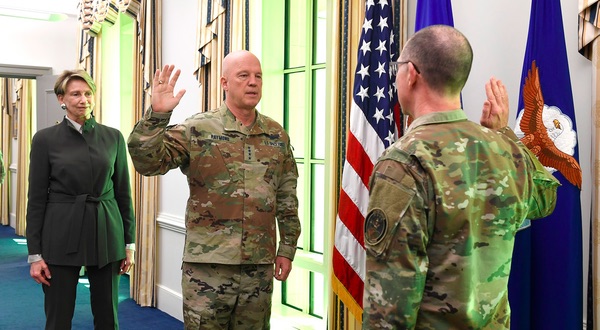Space Force: the struggle continuesby Taylor Dinerman
|
| In the long term, the nature and mission of the Space Force’s intelligence organization is going to determine whether the new service can accomplish its mission “to provide space capabilities to the joint force.” |
The Secretary of Defense and his office cannot make policy decision for Guard units without consulting Congress and state governors. This sometimes makes life difficult for the Pentagon’s so-called “E Ring Elephants” but it is essential to the well-being of our reserve forces and, more importantly, it reminds out military leaders of the reality of our republican form of government. The Constitution says that Congress has the power “To provide for organizing, arming, and disciplining the militia, and for governing such part of them as may be employed in the service of the United States.” A Space Force National Guard is obviously constitutional, and would be a small but valuable addition to our system of checks and balances. The question is now whether Congress and the Defense Department have the will to work together to create this small, but useful addition to America’s military power in space.
In the long term, the nature and mission of the Space Force’s intelligence organization is going to determine whether the new service can accomplish its mission “to provide space capabilities to the joint force.” Once the United States Space Force was established, it became obvious that it would have to have its own intelligence organization, and that this organization would be the 18th member of the intelligence community in the US. The argument now is over the new organization’s scope and mission.
One idea is to limit the Space Force’s intelligence service to studying and tracking satellites, space junk, and objects that are reactively close to the Earth, out to geosynchronous orbit. To some extent this is natural, as military activity is now concentrated in these orbits, but this could change rapidly. For example, a few years ago it was suggested that the US deploy space satellites, such as ones for the GPS system, that would be placed well beyond geosynchronous orbit to protect them from attack. When needed, they could be moved to more conventional positions. Ours in not the only nation with the capacity to place spacecraft in out-of-the-way locations. Such orbits might also be ideal places to hide killer satellites that could approach targets closer to Earth from “above,” so to speak.
At the very least, Space Force Intelligence must have the mission and ultimately the ability to observe and classify every bit of human made “stuff” in the Earth-Moon system. What used to be called Space Situational Awareness and is now called Space Domain Awareness cannot be limited to current military space practices.
In the US, the tracking of objects in space is currently the exclusive job of the military. With the expansion of commercial space activity, this mission may eventually be shared with civilian organizations such as the Office of Space Commerce. There is also an extensive network of amateur observers who work to track hard-to-spot space objects, as well as those not included in US military catalogs. This may help make the Space Force’s intelligence operations easier, but it will never relieve them of the duty to keep tabs on what is going on out there, especially on objects that might threaten US space assets.
There will be other controversies the Space Force and its supporters will have to deal with. Its role in missile defense is going to have to be clarified and defined. Its relations with spy satellite operators and users at the National Reconnaissance Office and the National Geospatial-Intelligence Agency will need to be clarified. The Defense Department and the Congress are going to be struggling with Space Force issues for a long time to come—assuming we come out of the pandemic alive.
Note: we are temporarily moderating all comments submitted to deal with a surge in spam.
